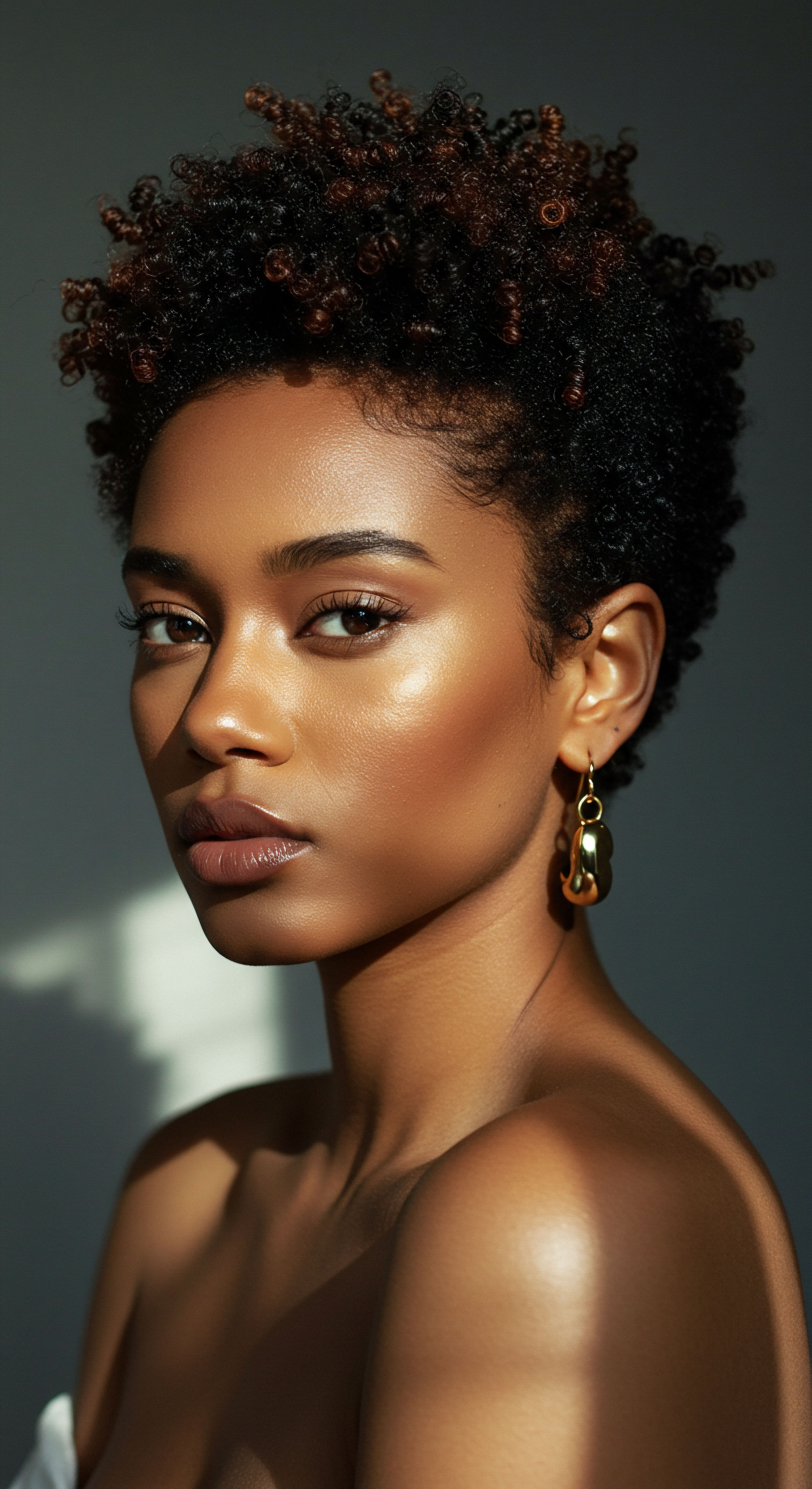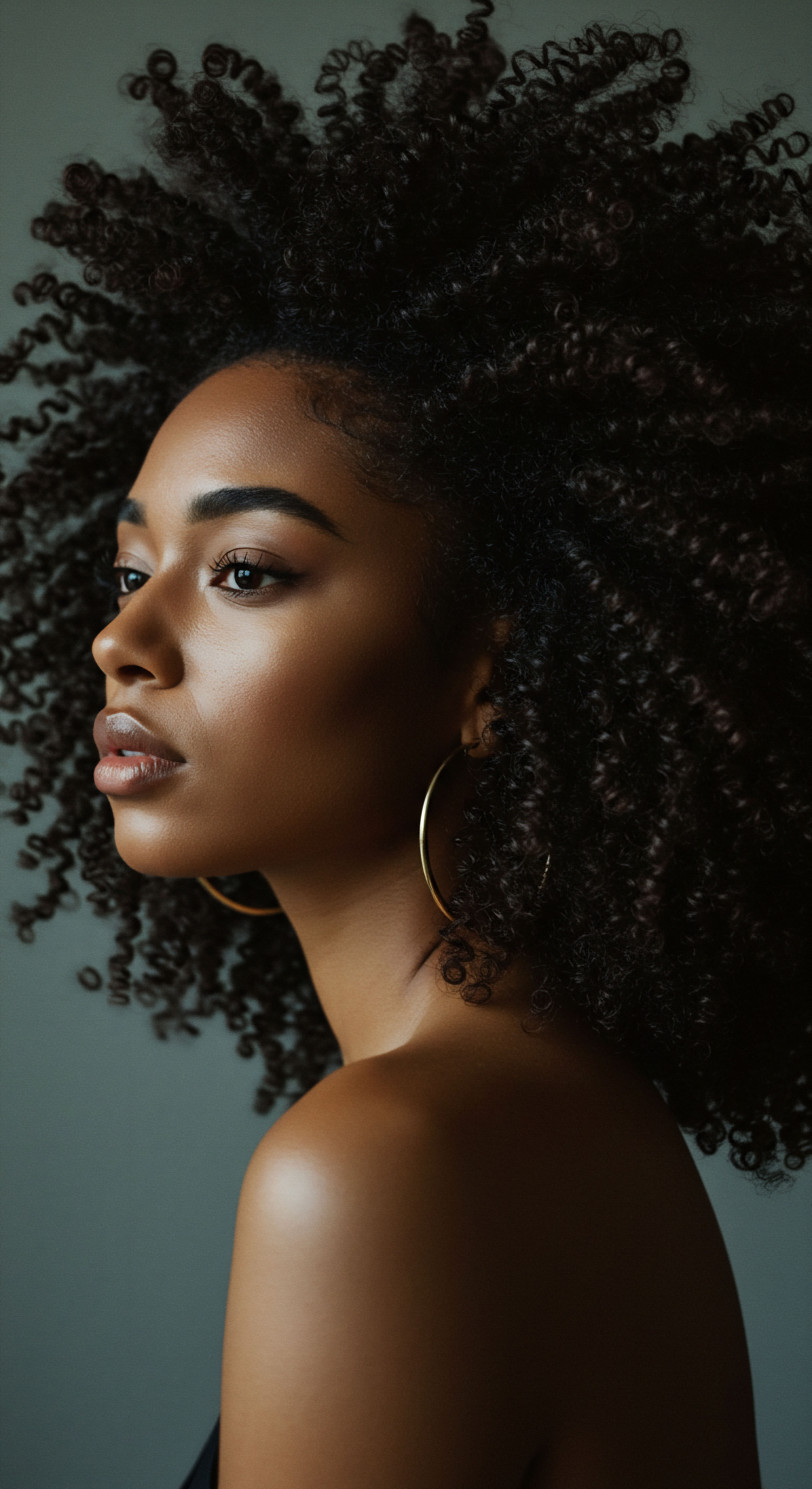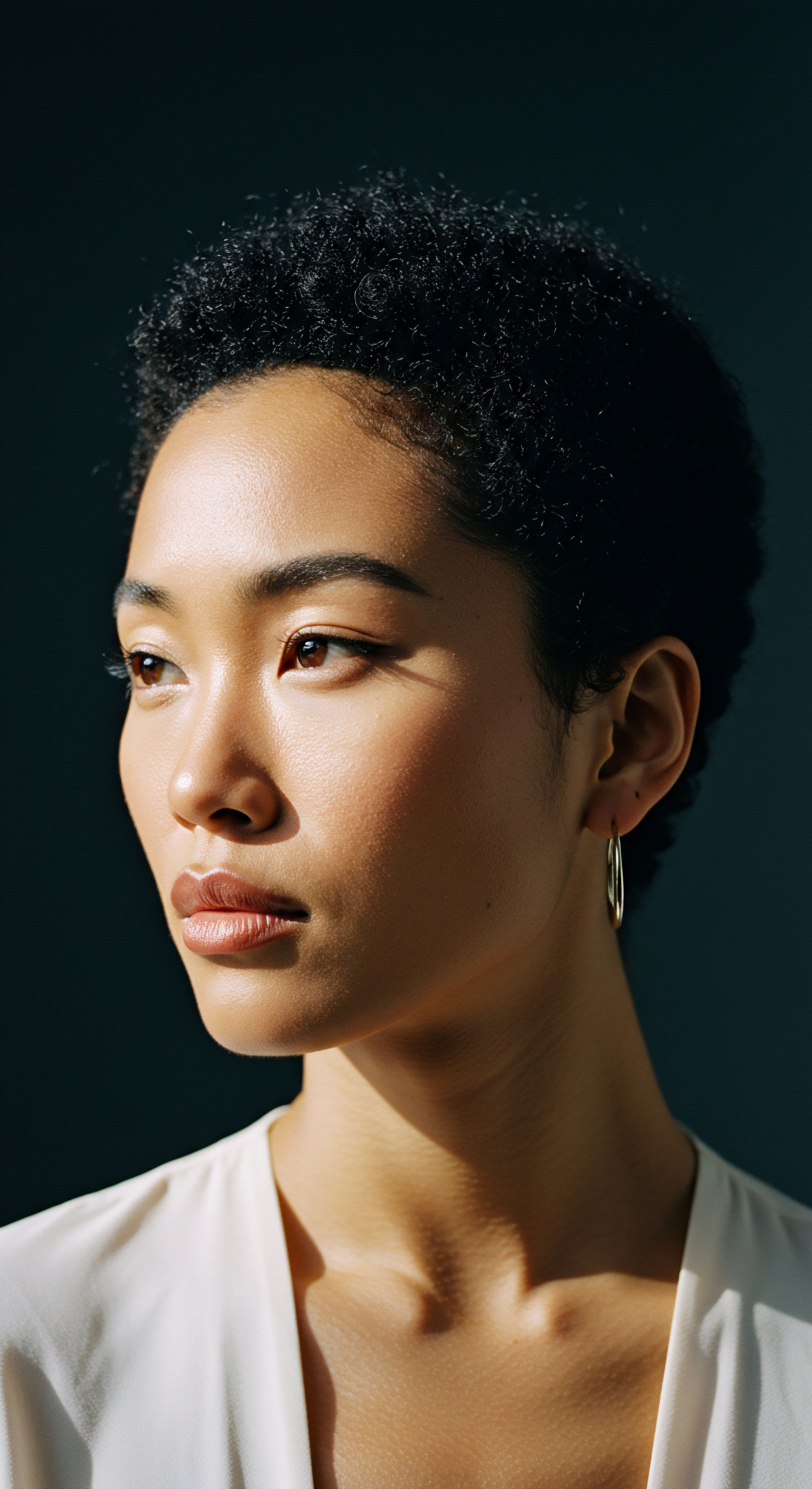
Roots
The quiet moments of slumber, often perceived as a simple cessation of daily activity, hold a profound and often underestimated influence on the vitality of our scalp. Beyond the surface, a nightly renewal takes place, a silent orchestration of cellular processes that directly shapes the health and appearance of our hair. It is within these hours of rest that the body tends to its most intricate systems, including the very foundation from which our strands emerge. Understanding this foundational connection helps us appreciate the deeper rhythm of our physical selves and how deeply our scalp relies on these restorative periods.

The Scalp’s Nightly Renewal Cycle
Our bodies, including the scalp, adhere to a biological rhythm, an internal clock known as the Circadian Rhythm. This rhythm dictates numerous physiological functions, synchronizing them with the cycle of day and night. During deep sleep, the body shifts into a dedicated mode of repair and regeneration.
This is a time when cell turnover significantly increases, allowing for the renewal of skin cells, including those on the scalp. Research indicates that skin cells can renew themselves up to eight times faster at night than during daylight hours, underscoring the critical nature of this nocturnal activity for maintaining a vibrant scalp environment.
The hair growth cycle itself, a continuous process of growth, transition, and rest, is profoundly influenced by this nightly restoration. The anagen phase, or the active growth stage, where hair follicles are most productive, benefits immensely from undisturbed sleep. When sleep is consistent and deep, the conditions are optimal for hair follicles to perform their essential functions, producing new hair with vigor. Conversely, disrupted sleep patterns can shorten this active growth phase, potentially leading to slower hair growth or increased shedding over time.
Undisturbed sleep creates an optimal environment for scalp cell renewal and vigorous hair growth.

Cellular Activity and Hormone Regulation
During the deep stages of sleep, the body orchestrates the release of various hormones vital for tissue repair and cellular proliferation. Among these are Growth Hormones, which play a direct role in the regeneration of hair follicles. Melatonin, often associated with sleep regulation, also appears to hold a significant role within the hair follicle itself, possessing antioxidant properties that may shield follicles from oxidative stress and stimulate cell growth.
Conversely, sleep deprivation can elevate levels of Cortisol, frequently termed the stress hormone. Chronically high cortisol levels have been connected to various forms of hair thinning, including telogen effluvium, a condition where hair follicles prematurely enter the resting phase, leading to excessive shedding. This hormonal imbalance, a direct consequence of insufficient rest, can disrupt the hair’s natural growth cycle, impeding its ability to grow without interruption.
- Cellular Regeneration ❉ During deep sleep, skin cells on the scalp regenerate at an accelerated pace, helping to repair daily damage and maintain a healthy skin barrier.
- Hormonal Balance ❉ Quality sleep supports the balanced production of hormones like growth hormone and melatonin, which are essential for hair follicle activity.
- Blood Flow ❉ Restful sleep improves circulation to the scalp, delivering oxygen and nutrients crucial for robust hair growth.

Why Scalp Health Matters for Textured Hair
For those with textured hair, the condition of the scalp is especially important. The unique structure of coiled and kinky strands means that natural oils may not travel down the hair shaft as readily as with straighter hair types, making the scalp the primary source of nourishment for the strands. A healthy, balanced scalp minimizes issues like dryness, irritation, and flaking, which can be particularly noticeable and challenging for textured hair.
When the scalp is compromised by insufficient sleep, these concerns can intensify, making styling and maintenance more difficult. The integrity of the scalp barrier, its ability to retain moisture, and its resistance to external stressors all depend on the regenerative processes that occur during restful periods.

Ritual
As daylight fades and the world quiets, a personal ritual begins for many, a quiet preparation for the restorative hours ahead. This nightly cadence, whether a simple winding down or a meticulous routine, holds unexpected power over the vitality of our scalp and hair. It is a moment to consciously prepare the hair for rest, safeguarding its integrity and supporting the biological processes that unfold during slumber. Recognizing this period as a time for gentle care allows us to transition from the day’s demands to a state of calm, extending that peace to the very roots of our hair.

The Protective Embrace of Nighttime Care
For textured hair, nighttime offers a significant opportunity for preservation. The natural inclination of textured strands to tangle and dry can be mitigated with thoughtful preparation. Sleeping without adequate protection can lead to friction against pillowcases, causing breakage, frizz, and moisture loss. This is where the tradition of protective styles and coverings gains its profound relevance.
Historically, head coverings have served a dual purpose ❉ practical protection and cultural expression. From the mid-1800s, European women wore sleep caps to keep hair neat and warm. In African regions, headwraps, known by names like dukus or doek, carried deep cultural meaning, signifying wealth, marital status, and emotional state.
During periods of enslavement, these coverings even became symbols of resistance and coded communication among Black women. Today, for many with textured hair, the bonnet or silk scarf is a continuation of this legacy, a simple yet powerful tool for hair preservation.

Choosing Your Nighttime Allies
The choice of nighttime hair covering plays a considerable role in supporting scalp health. Materials like silk and satin are particularly beneficial due to their smooth surfaces. Unlike cotton, which can absorb moisture from the hair and create friction, silk and satin allow hair to glide, reducing tangles, breakage, and moisture depletion. This reduction in friction also minimizes mechanical stress on the scalp, which can otherwise lead to irritation or sensitivity.
| Material Type Silk |
| Primary Benefit for Scalp Reduces friction, minimizes irritation |
| Primary Benefit for Hair Retains moisture, reduces breakage and frizz |
| Material Type Satin |
| Primary Benefit for Scalp Smooth surface, less moisture absorption |
| Primary Benefit for Hair Prevents tangles, preserves style |
| Material Type Cotton |
| Primary Benefit for Scalp Can cause friction and dryness |
| Primary Benefit for Hair Absorbs moisture, leads to frizz and breakage |
| Material Type Selecting the proper material for nighttime hair coverings significantly impacts scalp and hair health. |
Beyond coverings, preparing the hair itself before bed is a ritual that supports the scalp. Gentle detangling, applying light oils or leave-in conditioners, and styling hair into loose braids or twists can prevent matting and tension on the scalp during sleep. This careful preparation ensures that the scalp is not unduly pulled or stressed, allowing its natural restorative processes to unfold without impediment.
Nightly rituals, particularly protective styles and silk coverings, significantly reduce mechanical stress and moisture loss for the scalp and hair.

Does Nighttime Hair Preparation Really Matter?
The subtle acts of nighttime hair preparation, often overlooked, contribute to the overall resilience of the scalp. By minimizing friction and preventing moisture loss, these rituals indirectly support the scalp’s barrier function. A compromised skin barrier, whether on the face or scalp, is more susceptible to irritation, dryness, and the entry of environmental stressors. Studies have shown that sleep deprivation can impair skin barrier function, leading to increased transeansepidermal water loss and reduced skin hydration.
Therefore, protecting the hair at night helps to counteract some of these potential vulnerabilities, maintaining a more stable and healthy scalp environment. The conscious choice to care for one’s hair before rest becomes a quiet act of self-preservation, reflecting a deeper respect for the body’s natural cycles.

Relay
Beyond the visible rituals and the basic science, the profound influence of sleep quality on scalp health delves into a complex interplay of biological signals and systemic responses. It is a dialogue between the rhythms of rest and the intricate mechanisms governing our skin’s vitality, a conversation that shapes the very environment from which our hair emerges. To truly appreciate this connection, we must look beyond the surface, into the cellular whispers and hormonal shifts that occur while we slumber.

The Silent Orchestra of Hormones and Scalp Balance
Sleep acts as a conductor for a silent orchestra of hormones, each playing a part in maintaining scalp equilibrium. The balance of Sebum Production, the natural oil that conditions the scalp and hair, is directly influenced by sleep patterns. Insufficient sleep can disrupt the hormones that regulate sebum, potentially leading to either an overly oily or excessively dry scalp, both of which can foster conditions like dandruff or irritation. Research indicates that sebum production is more balanced in individuals who consistently achieve 7-8 hours of sleep.
The interplay of hormones extends to those governing hair growth itself. Growth hormone, primarily secreted during deep sleep, is essential for the cellular regeneration of hair follicles. When sleep is consistently disrupted, this vital hormone’s secretion can be impeded, affecting the hair’s natural growth trajectory. Furthermore, the pineal gland produces melatonin, a hormone recognized for its role in regulating sleep-wake cycles.
Beyond this, melatonin possesses significant antioxidant properties and has been observed to stimulate cell growth in hair follicles, protecting them from oxidative stress. This suggests a direct link between the quality of our rest and the very resilience of our hair’s growth centers.

When Sleep Interrupts the Hair Cycle
The hair growth cycle, with its anagen (growth), catagen (transition), and telogen (resting) phases, is highly sensitive to disruptions in sleep quality. When sleep is inadequate, the body’s stress response activates, leading to an increase in cortisol. This elevated cortisol can prematurely push hair follicles into the telogen, or resting, phase, resulting in increased shedding. This condition, known as Telogen Effluvium, can cause noticeable hair thinning.
A particularly intriguing aspect of this connection lies in the relationship between sleep disorders and hair thinning. A study examining the relationship between Sleep Apnea and hair loss in men found that while sleep apnea had a negligible effect on men not predisposed to male pattern baldness, those with a predisposition were highly likely to experience hair thinning or loss correlated with their sleep apnea. This suggests a more complex interaction where pre-existing genetic tendencies can be exacerbated by sleep-related physiological stressors, underscoring the subtle yet potent influence of nighttime respiration on hair vitality.

How Does Chronic Sleep Disruption Affect Scalp Immunity?
The scalp, like the rest of the skin, functions as a protective barrier and houses its own immune system. Chronic sleep disruption can compromise this defense. Studies have shown that sleep deprivation can lead to increased levels of pro-inflammatory cytokines, such as IL-1β and TNF-α. These inflammatory markers, when persistently elevated, can contribute to various skin conditions, including those affecting the scalp, such as seborrheic dermatitis.
A compelling animal study conducted in 2012 demonstrated that 48 hours of selective paradoxical sleep deprivation in mice with psoriasis led to significant increases in specific pro-inflammatory cytokines (IL-1β, IL-6, and IL-12) and decreases in the anti-inflammatory cytokine (IL-10). These changes were normalized after 48 hours of sleep rebound. This research suggests that sleep deprivation can intensify inflammatory responses in the skin barrier, potentially worsening existing scalp conditions or contributing to their onset. The immune system’s delicate balance, essential for a calm and healthy scalp, appears deeply intertwined with the restorative power of consistent, quality sleep.
- Immune Dysregulation ❉ Sleep deprivation can increase pro-inflammatory cytokines, contributing to scalp irritation and conditions.
- Oxidative Stress ❉ Lack of sleep may increase reactive oxygen species, leading to cellular damage and inflammation on the scalp.
- Barrier Compromise ❉ Insufficient sleep can impair the scalp’s protective barrier, making it more vulnerable to external irritants and moisture loss.

The Circadian Clock and Hair Follicle Stem Cells
At a deeper cellular level, the circadian clock directly influences the behavior of hair follicle stem cells. These remarkable cells are responsible for regenerating hair throughout life. Research indicates that the hair follicle stem cell niche contains populations of cells at different phases of the circadian clock, which are differentially predisposed to respond to growth signals. The core clock protein, BMAL1, modulates the expression of stem cell regulatory genes in an oscillatory manner, influencing whether stem cells are more or less prone to activation.
Disrupting this delicate circadian equilibrium, through genetic alterations like the deletion of BMAL1, has been shown to result in a progressive accumulation or depletion of dormant stem cells in mouse models. This disruption can also lead to premature aging of the epidermis and affect hair growth. While direct human studies on this specific mechanism are ongoing, the findings from animal models highlight the profound, often unseen, ways in which our internal biological clock, heavily influenced by sleep, directly governs the regenerative capacity of our hair follicles. The rhythmic activity of these clock genes within the hair follicle itself is a testament to the sophisticated design underlying hair health, a design that thrives on consistent, restorative rest.
Sleep quality profoundly influences scalp health by regulating hormones, modulating immune responses, and orchestrating the activity of hair follicle stem cells.

Reflection
As we close this exploration into the intricate dance between sleep and scalp health, a quiet understanding settles. The vibrant life of our hair, so often attributed to external applications and visible care, draws its true sustenance from the unseen rhythms of our rest. The gentle hush of night, the profound work of cellular repair, the careful balance of internal systems – these are the foundations upon which a thriving scalp and resilient hair are built.
It is a subtle reminder that genuine well-being begins within, a harmonious internal landscape reflected outward in the vitality of our strands. May this contemplation inspire a deeper reverence for the restorative power of slumber, inviting a more mindful approach to nurturing ourselves, from crown to soul.

References
- Baron, E. D. et al. (2019). “Night shift work and skin conditions ❉ A pilot study.” Journal of the American Academy of Dermatology .
- Hsu, Y.-C. et al. (2019). “Stress and the hair growth cycle ❉ Cortisol-induced hair growth disruption.” Journal of Drugs in Dermatology .
- Irwin, M. R. et al. (2016). “Sleep and inflammation ❉ reciprocal regulation and functional implications.” Frontiers in Integrative Neuroscience .
- Janich, P. et al. (2013). “The circadian molecular clock creates epidermal stem cell heterogeneity.” Nature .
- Lin, K. K. et al. (2009). “Clock and Bmal1 play essential roles in regulating the hair follicle cycle.” Developmental Cell .
- Plikus, M. V. et al. (2013). “The circadian clock in skin ❉ implications for adult stem cells, tissue regeneration, cancer, aging, and immunity.” Nature Reviews Genetics .
- Szentirmai, É. & Kapás, L. (2019). “TNF-α knockout mice display similar patterns of sleep and no deficiency in sleep regulation compared with wild type mice.” Journal of Sleep Research .
- Yehuda, S. et al. (2009). “REM sleep deprivation for 72 h in rats led to significant increases in plasma IL-6, IL-1β, and TNF-α expression.” Journal of Neuroimmunology .
- Altemus, M. et al. (2014). “Stress-induced skin barrier disruption ❉ Implications for the pathogenesis of atopic dermatitis.” Journal of Investigative Dermatology .
- Kahan, V. et al. (2010). “Can poor sleep affect skin integrity?” Medical Hypotheses .
- O’Donoghue, L. & Zaenglein, A. L. (2020). “The role of sleep in dermatology.” Journal of the American Academy of Dermatology .
- Reis, C. R. et al. (2012). “Sleep loss and cytokines levels in an experimental model of psoriasis.” Journal of Investigative Dermatology .
- Wright, K. P. et al. (2015). “Influence of Sleep Deprivation and Circadian Misalignment on Cortisol, Inflammatory Markers, and Cytokine Balance.” Brain, Behavior, and Immunity .
- Gupta, M. A. & Gupta, A. K. (2013). “The psychosocial impact of hair loss.” Journal of the American Academy of Dermatology .
- Chennaoui, M. et al. (2011). “One night of acute sleep deprivation induced significant increases in TNFα levels.” Brain, Behavior, and Immunity .